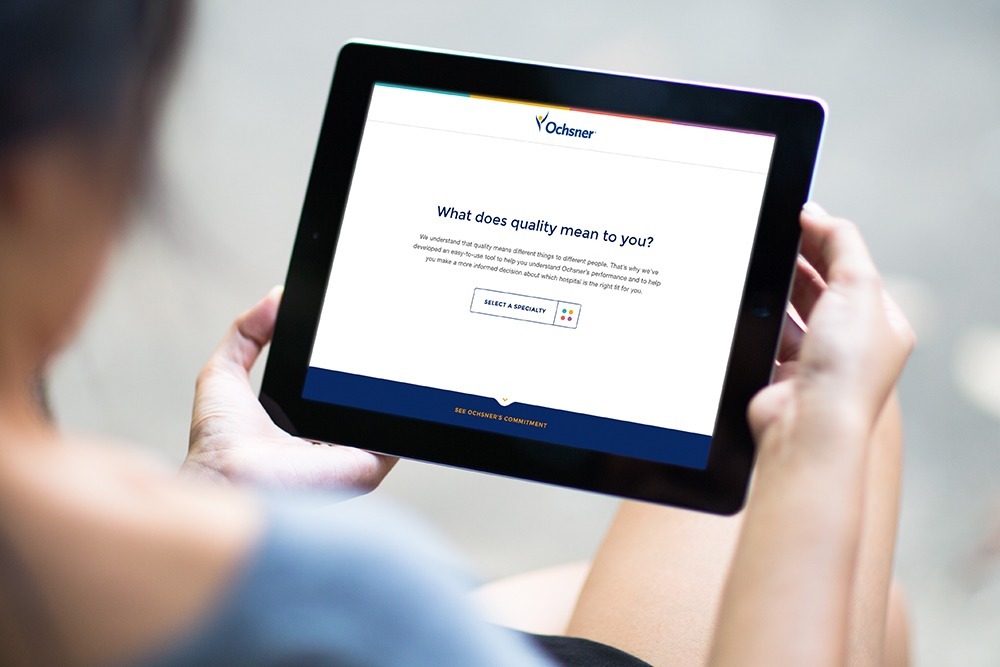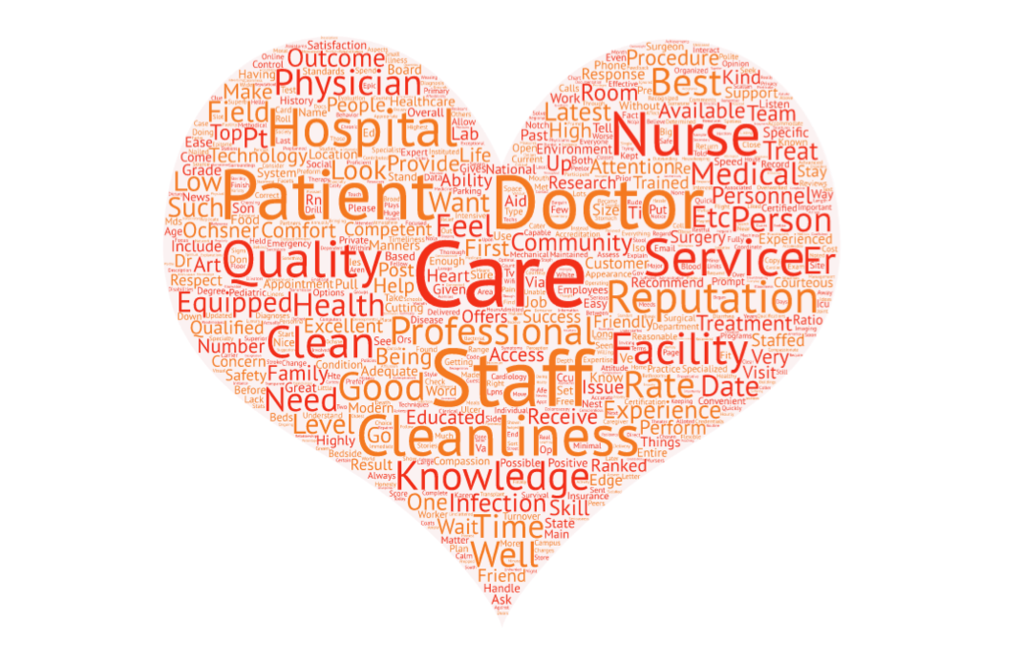Delivering a Consumer-Centric Quality and Safety Experience
// By Amber Welch //
 Need to book a hotel? Customer ratings and reviews are just a click away. Shopping for a car? You can easily compare features and overall quality on Consumer Reports. Looking for a new yoga class? Read the reviews.
Need to book a hotel? Customer ratings and reviews are just a click away. Shopping for a car? You can easily compare features and overall quality on Consumer Reports. Looking for a new yoga class? Read the reviews.
But what about choosing a hospital, perhaps the most important purchase in your life? For the few hospital websites that do feature quality data, you typically have to dig deep within the site only to find complex data organized by health policies using insider jargon and some pretty confusing charts.
While this information—and the format it is presented in—is extremely valuable to hospital administration, it is far less valuable to the everyday consumer. It’s no wonder that just a few years ago, only 14 percent of internet users consulted hospital reviews and ratings online[1]. And another report showed that some patients might not even recognize the possibility that quality may differ from one hospital to the next[2]. There is a huge gap in consumer education around quality and safety data, and the current methods of communicating it don’t seem to be doing the trick.
 So, in 2016 at Ochsner Health System, we began to question this status quo. In light of increasing consumerism in which patients have a greater voice in where they choose to seek care, we asked, “Why wouldn’t we allow our health consumers the same experience they get when evaluating the quality and safety of cars on Consumer Reports? Why wouldn’t we allow the same ease of access to the quality of healthcare organizations?”
So, in 2016 at Ochsner Health System, we began to question this status quo. In light of increasing consumerism in which patients have a greater voice in where they choose to seek care, we asked, “Why wouldn’t we allow our health consumers the same experience they get when evaluating the quality and safety of cars on Consumer Reports? Why wouldn’t we allow the same ease of access to the quality of healthcare organizations?”
Over the next few months we worked with White Rhino to rethink the quality and safety data experience for Ochsner consumers. Now, in addition to checking the box to publish quality and safety data on our website, we deliver a consumer-friendly and interactive experience that provides information to help make better decisions about where they seek care. Here’s a brief look at our journey and what we learned along the way.

Patients Don’t Define Quality the Way We Do
Our first step in rethinking how to educate consumers about quality and safety data was to ask them what they were looking for. We put out a survey to our patient panel and conducted one-to-one qualitative interviews to get to the root of how they define quality.
We were happy to find out that 92 percent of patients report quality as important when selecting a hospital. But we also learned that only 71 percent cited “measures of care” (such as mortality rate, medical error rate, and readmission rate) as an important factor. To understand this gap and what other factors Ochsner consumers consider, we asked open-ended questions: “When it comes to choosing a hospital, how do you define the word quality? What specific things do you consider to assess quality?”
Their answers had little to do with the traditional measures you might find on the Centers for Medicare & Medicaid Services (CMS) website, and everything to do with how a hospital treats its patients. Some responses that stood out:
- Caring staff
- You are not ignored
- The professionalism of staff
- You are treated with kindness and compassion
- Attentive, professional, courteous, compassionate staff
We also created a word cloud of all of the responses, which allowed us to quickly see how important these “softer” measures of quality are to our patients.
When we began to design our new quality and safety experience, we wanted to recognize that consumers all have their own definitions of quality, and show that we really do have their best interests at heart. Because, in the end, while we’d love for them to choose Ochsner, our ultimate goal is for them to be able to make a more informed decision about which hospital is the right fit for them.
Pulling Inspiration from Other Industries
Consumer Reports was not the only place we looked for inspiration. We also looked at how the finance industry educates consumers about 401(k) planning. This was especially important because, like 401(k) planning where you can’t truly appreciate the value until 40 or 50 years in the future, we don’t want our community to be researching quality and safety data when they are too sick to evaluate it at all. Instead, we want to equip Ochsner consumers well in advance of needing to make an important health decision.
We looked at some of the best 401(k) planning calculators we could find and noticed that they all had one thing in common: They told a personal story. They helped consumers envision the future that would result from making smart decisions today. They also allowed consumers to tailor this future vision based on personal preferences, such as selecting a more aggressive or conservative investment style.
In Ochsner’s quality tool, we allow similar customization to paint a personalized picture for each visitor. In addition to selecting which specialty they are most interested in, users are asked to tell us which measures of quality—from convenience to expertise to risks—are most important to them. Based on their selections, each user receives a dashboard of quality measures they might factor into their decision-making process.
Thinking of Quality and Safety as a Journey
It was also important that we limit the number of quality measures served up to each user. Our goal was not to compete with websites like CMS, but to serve as a steppingstone to educate consumers and make them aware of the types of factors they should consider when selecting a hospital.
The CMS website is full of factual and trustworthy information, but we’d like to equip consumers with something a little more digestible to start. When buying a car, consumers don’t immediately look at detailed measures of torque and other factors. Instead they look at horsepower. It’s not a full depiction of the power of the car, but it’s a simple way begin to understand the concept that one car might be more powerful than another.
In our reimagined quality and safety experience, we serve up just four relevant measures of care to each user so that they may become familiar with a few ways in which hospital quality might differ from one hospital to the next. For those ready to dig deeper, we link to other resources.
Unexpected Benefits
When we set out to rethink our quality and safety experience, we wanted to create an experience that was “just what the consumer ordered.” But it’s turning out to also be a great marketing tool.
This new experience is something that’s shareable, and it is already starting to bring greater levels of visitor engagement. And with tracking and analytics, it’s a way for us to capture insightful information about our audience. In the future, we see opportunities to layer in email nurture flows and remarketing.
As the director of digital content for Ochsner Health System, Amber Welch steers online and digital strategies from SEO and SEM to website and social content for the Marketing and Communications teams.
To learn more about Ochsner’s quality initiative and other ways hospitals are creating a more consumer-centric digital experience, see Amber and White Rhino speak May 10 at The Forum for Healthcare Marketing & Physician Strategies Summit.
Related Articles
Patient Engagement Through Digital at Intermountain Healthcare
[1] Peer-to-Peer Health Care. 2013. http://www.pewinternet.org/2013/01/15/peer-to-peer-health-care/
[2] Lagu T, Lindenauer PK. Putting the Public Back in Public Reporting of Health Care Quality. JAMA. 2010;304(15):1711-1712. doi:10.1001/jama.2010.1499.


